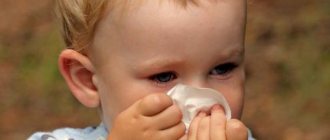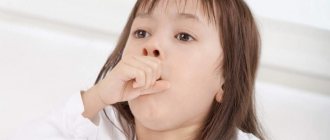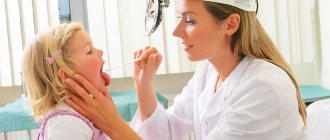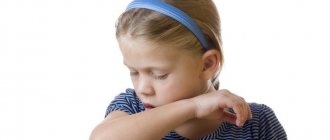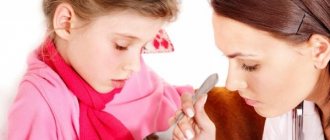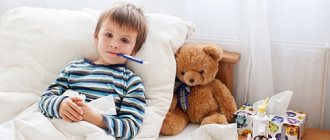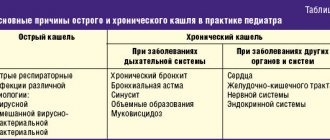Very often, parents do not know how to treat a child’s cough when it is exhausting, keeps him awake at night, and causes vomiting. It is possible that the throat is inflamed and the lymph nodes are enlarged when a foreign body enters the respiratory tract. Sometimes a nervous cough occurs, triggered by an inflammatory process in the nervous system, an allergic reaction, or the development of diseases in the intestines, stomach, or heart.
Cough medicines for children
Parents should remember that there is no universal cough medicine. When prescribing drug therapy, the attending physician takes into account the possible causes of this phenomenon. Each remedy is used in specific circumstances and affects the child’s body in a certain way.
Sometimes medications are used to disable the cough center. Codeine is considered one of these drugs; it has a depressant effect and suppresses cough. Such medications are contraindicated for children because they belong to the narcotic group.
There are cough medications that have a non-narcotic effect, but require caution when taken and monitored by a doctor. Among them are known such as Sinekod, Tusuprex, Glaucine and others. They inhibit the cough reflex and weaken the signals coming from the affected mucous membrane in the bronchial tree. These medications are rarely prescribed to young children, only in exceptional cases.
Uncontrolled use of antitussives leads to serious consequences. With the help of cough, the bronchi and lungs are cleared of excess phlegm and harmful microorganisms. When this function is inhibited or disabled, the most favorable conditions are created for the occurrence and development of infection. In the presence of a wet cough, excess sputum, stagnating in the body, disrupts the ventilation function, causing bronchitis or pneumonia.
Cough treatment - what you need to pay attention to
How to cure a child’s cough at home - this question worries all relatives and friends if the baby begins to cough.
And the first thing parents do is go to the pharmacy to buy “something for a cough.”
In most cases, the random choice of a drug to treat a cough turns out to be incorrect and only aggravates the course of the disease. At the same time, the instructions and indications for its use are rarely specified, and the low or, conversely, high price of the drug in some cases is decisive. Only a doctor knows what medications the child needs, their correct dosage, frequency of administration and duration of treatment.
It is important to know:
Cough therapy is not aimed at eliminating the cough reflex with antitussive drugs, but treating the underlying disease:
- reduction of the inflammatory process and swelling of the mucous membrane in a certain area of the bronchopulmonary system;
- reducing the viscosity of sputum, which irritates the mucous membranes;
- disruption of activity and normal functioning, viruses and bacteria;
- increasing the child’s immunological reactivity;
- removal of a foreign body;
- therapy for diseases of other organs that provoke cough (heart, nervous pathologies, diseases of the digestive tract, endocrine and metabolic disorders).
Only an integrated approach allows you to quickly and effectively treat cough in children at home
Treatment of cough in children at home should be started:
- from creating comfortable indoor conditions (humidifying dry air, a favorable atmosphere with the exception of stress, loud sounds and irritating odors);
- warm, generous drinks: there is no need to give the child a lot to drink at once - a few sips of raspberry tea, herbal infusion, milk with honey or figs every 10-15 minutes to reduce inflammation and intoxication and soften a dry cough;
- food should be gentle, warm in the form of pureed dishes, so as not to irritate the inflamed nasopharynx and reduce the load on the digestive system;
- with additional vitamins in food and drink - warm diluted freshly prepared juices, cranberry juice, raspberries or black currants, mashed with sugar, honey and lemon;
- with the use of natural phytoncides (garlic and onion) and plant immunostimulants (adaptogens) - echinacea, eleutherococcus, Rhodiola rosea.
The most important factor in the treatment of cough in a child is the correct choice of a combination of medications and an antitussive.
There are several types of drugs for treating cough in children:
| Group of drugs | Action | Drugs |
| Centrally acting antitussives | They actively inhibit the cough reflex, affecting the cough center. Prescribed only by a specialist |
|
| Expectorants and enveloping agents | Stimulate expectoration and soften cough |
|
| Mucoactive drugs (mucolytics) | Actively liquefy viscous secretion and stimulate its removal from the bronchi |
|
| Drugs, stimulating gastropulmonary reflex (expectorants, mucokinetics) | They enhance the physiological activity of the epithelium and the peristaltic movements of the bronchioles. A side effect of this group is an increase in the gag reflex | Preparations containing:
|
| Drugs that alter the activity of bronchial glands |
|
|
| Combination drugs | A combination of several active components from different groups. Most often this is an antitussive and guaifenesin or a mucolytic + anti-inflammatory agent These medications should be prescribed with extreme caution and under the supervision of a physician. |
|
Often the wrong choice of drug for cough therapy causes:
- inhibition of the cough reflex and gradual development of complications (obstructive bronchitis, pneumonia, pleurisy);
- worsening cough (due to active dilution of sputum or overirritation of the mucous membrane in the absence of sputum with a dry cough);
- descent of the inflammatory process into the lower sections and accumulation of sputum in small bronchioles and alveoli;
- the occurrence of adverse reactions.
Only a specialist who can prescribe the necessary treatment can determine the localization of the pathological process in the child’s respiratory tract.
To prescribe the correct treatment, it is important to clarify the localization of the inflammatory process and a preliminary diagnosis, which allows you to determine what type of cough the child has: how to treat it at home or whether it is necessary to hospitalize the baby in a hospital for intensive care.
pediatrician Sazonova Olga Ivanovna
Article read: 796
Antitussives
There are two groups of cough medicines. The first group consists of sedatives used for dry coughs. With their help, irritation in the respiratory tract is reduced, which relieves coughing attacks. Another group includes expectorants, which dilute mucus during a wet cough and remove it from the respiratory tract.
The classification of antitussive drugs includes drugs of central, peripheral action and combination drugs. Additionally, these medications are divided into narcotic and non-narcotic. Children are prescribed non-narcotic medications that suppress cough and are not addictive.
A classic example is Sinekod. The central nervous system reacts to its effects, and the cough subsides immediately after taking it. Such symptomatic treatment normalizes the baby, relieves bronchial spasms and makes breathing easier. As a result of taking Sinecode in combination with other drugs, recovery occurs faster.
How to treat a child: modern drugs
Medicines should not be given to a child thoughtlessly. Pharmaceutical companies offer a large selection of drugs that can relieve simple bronchospasm. They affect various areas of the body - the nervous system, the mucous membrane of the respiratory system and receptors that cause spasms.
On this topic:
Subtleties of treating cough in an infant
Cough remedies for children should be chosen carefully. Each drug is intended for a specific age. For children over one year old, medications made from plant extracts are suitable.
Drugs are divided into several groups according to their mechanism of action:
1. Expectorants are the best remedy if you need to remove phlegm from the bronchi. Doctors prescribe them if a child is over 3 years old and has a spasm due to an inflammatory process in the respiratory system. Most expectorant medications contain extracts of safe plants. How to treat a child’s cough if you need to remove mucus from the lungs? The following medications can be seen in a pediatrician's prescription:
- Lazolvan or Ambrobene;
- Equabal – contains plantain extract, can be given from the age of six months;
- Prospan - based on ivy, prescribed for coughs of a one-year-old baby;
- Marshmallow extract.
2. Mucolytics - affect the physical characteristics of mucus in the respiratory organs. This cough medicine is prescribed to children if they need to make the spasm fruitful. Pediatricians prescribe such drugs if the sputum is excessively viscous. These medications include: ACC, Fluditek and Bronchobos.
3. Antitussives - medications can be given only during dry bronchospasms. They act on the nervous system, inhibiting the area of the brain responsible for the spasm reflex. In the pediatrician's prescription you can most often see Sinecode. If a parent is in doubt about what to give their child for an illness, then they should make an appointment with a specialist.
4. Bronchodilators - prescribed for symptoms of bronchial asthma.
5. Homeopathy – often prescribed to children under 5 years of age, since the medications have no contraindications.
6. Local remedies are warming ointments, patches and rubbing. A child’s cough should be treated with these drugs only after consulting a doctor. Warming compressors should not be prescribed to children with heart disease.
How to treat a child’s cough is a question that concerns many mothers and fathers. Only a medical institution will tell you what to give correctly. There is no need to consult with pharmacy clerks or neighbors if you want to choose competent therapy and safe procedures.
Mucolytics
The main purpose of mucolytic drugs is to thin the sputum. These medications differ in the content of ambroxol, acetylcysteine, bromhexine, carbocisteine, sobrerol and other similar substances. They are included in cough syrups intended for children.
These products are prohibited for use if the child has not reached the age of two. This is due to the weak development of the cough reflex during this period. Taking mucolytics dilutes sputum and increases its volume, which the baby cannot cope with. As a result, such treatment leads to severe respiratory complications. Therefore, in young children, treatment for a wet cough consists of rinsing the nose with saline, humidifying the room and drinking plenty of fluids.
Medicines
Curing a cold at home is not easy, since therapy must be comprehensive after an accurate diagnosis by a pediatrician. Parents need to take into account the weight and age of their children when dispensing tablets and syrups, and also do not neglect the instructions, doses, and doctor’s recommendations.
- Antitussive drugs (non-narcotic, narcotic) are prescribed for obsessive attacks. It should be given to children under one year of age with caution; there may be side effects (constipation, addiction).
- Expectorants (Kudrin, Glycodin, Codelac, Panatus, Sinekod). But such drugs can only intensify attacks and are not used in the treatment of upper respiratory tract diseases. So, a slight cough in the evening closer to night can turn into an attack and obsession.
- Preparations of plant origin, such as licorice, elecampane, pine, plantain, thermopsis, or for combined effects with the addition of chemicals (sodium benzoate, potassium bromide).
- Mucolytics (tablets, lozenges, drops) with an expectorant effect to restore the elasticity of the mucous membrane, thin the mucus, without leading to its accumulation and increase in volume: Pertussin, Doctor Mom, Doctor Theiss, Bronchicum, Gedelix, Eucabal, Mucosol, Prospan, Lazolvan , Mukobene, ACC, Ambrobene, Flavamed.
- Mint lozenges for producing a dry cough into a wet one (Thermopsis, Mucaltin, Tusuprex).
- Syrups for children under one year of age with ARVI: Pertussin, Doctor Mom, Ambroxol, Bromhexine.
- Breastfeeding for sore throat, excessive dry mouth, to thin mucus and remove it from the respiratory tract (licorice, marshmallow).
- Immunomodulatory drugs (Viferon, Kipferon, Anaferon, Arbidol) to strengthen the immune system.
When a dry attack begins, children under 2 years of age are additionally recommended physical procedures: electrophoresis, magnetic therapy, inhalations, chest massage.
If a manifestation of a chronic disease is noticed in newborns under 1 year old - an increase in temperature to 39-40 degrees, the appearance of shortness of breath, then parents need to urgently call a doctor or an ambulance, even if the cough is dry and has just begun.
Expectorants
When you cough, the mucous membrane first becomes inflamed, and then sputum is formed. Depending on the presence or absence of sputum, the cough can be dry or wet. Therefore, coughing is important, with the help of which accumulated mucus is removed from the respiratory tract.
Expectorants are divided into two types. Secretolytic drugs dilute sputum and increase its quantity. Mucolytics also thin mucus and improve expectoration. For the treatment of children, the first option is more often used. Among these drugs, Flavamed should be noted, which has mucolytic, secretomotor and secretolytic effects. The therapeutic effect of the drug is provided by ambroxol hydrochloride, which is an active substance from the group of secretolytics. The sputum is liquefied by direct action on the secretion, leading to expectoration. As a result, a wet cough decreases, the inflammatory process in the bronchi decreases, and the conditions for the appearance and development of pathogenic microorganisms in the respiratory tract are eliminated.
Among the expectorant drugs, it should be noted: Gedelix, Mucaltin, Doctor Mom herbal syrup, Bromhexine, licorice root and others. The prescription of the medicine and dosage is made by the pediatrician after examining and examining the sick child.
Treatment measures
Before you learn how to treat a beginning cough and select a therapeutic course, it is important to identify the true causes and monitor at what hours the baby coughs most often and whether sputum is released.
If:
- coughing is caused by acute respiratory infections and acute respiratory viral infections, then treatment is appropriate;
- additionally, a runny nose and a sore throat have appeared; it is worth gargling with drops, solutions, decoctions, infusions (furacilin, sea salt, soda, sage) to relieve inflammation and remove microorganisms;
- if a child’s hard cough goes away, then it is necessary to facilitate its transition to a wet one by giving children warm milk with the addition of butter, licorice (root), thermopsis, honey or tea with the addition of ginger, lemon;
- coughing is short-term, which happens with bronchial asthma, tuberculosis, chronic bronchitis, then it is necessary to quickly remove foreign bodies from the respiratory tract to the outside, to achieve the discharge of sputum;
- there is pain in the sternum and a hard cough, when there is a high probability of inflammation of the pulmonary membrane, then home methods are dangerous and ineffective.
It is necessary to treat a child’s beginning cough by ensuring bed rest, ventilating the room and avoiding excessive dry air to avoid the disease developing into bronchitis and laryngitis.
Folk remedies for cough
Not only traditional medications are used to treat cough. There are many recipes in folk medicine that are no worse than drugs in terms of effectiveness.
A popular tincture based on honey and radish is used for wet coughs. A hole is cut into the radish into which one teaspoon of honey is placed. The mixture of radish juice and honey is infused for at least four hours. The finished product is consumed at intervals of three hours, 1 - 2 teaspoons.
Treatment is often carried out using banana decoction. To prepare, take bananas (2 pcs.), sugar (2 tablespoons) and water (150 g). The resulting mixture is boiled. The resulting product has an enveloping effect and promotes the removal of phlegm. The decoction is consumed after meals for 3-4 days. A mixture of honey and onion juice has an expectorant effect. To obtain the drug, honey in the amount of two teaspoons is added to the chopped onion. The resulting mixture is infused for at least three hours. The finished product is taken before meals. For young children, a single dose is 1 teaspoon, and for older children - 2 teaspoons.
Folk remedies to combat bronchospasm
In modern society, many do not refuse their grandmother’s methods to cure bronchospasm. Decoctions and drinking plenty of berry fruit drinks help rid the body of toxins and remove phlegm, which contains the main infection. If your baby suffers from dry bronchospasm, you can choose the following methods of traditional therapy:
- Honey and radish - the effectiveness of this method has been proven since ancient times. Black radish must be peeled and cut into slices. The product is placed on a baking sheet and poured with honey, placed in the oven for 100-120 minutes. The juice released after heat treatment is poured into a convenient container. This product is consumed 3 times a day, 2 teaspoons before meals.
- Onions and honey - you need to take these ingredients in equal parts and mix them into porridge. The product is given one tablespoon after meals.
- Carrot juice is a panacea for many colds. This drink is recommended for children to drink regularly; it helps strengthen the immune system and removes toxins that poison the body of a young patient. If your child is disgusted by drinking carrot juice, you can mix it with apple or orange concentrate.
- Viburnum decoction - you need to take a glass of berries and pour a liter of boiling water. The broth simmers on fire for 10-15 minutes. The drink is filtered and cooled, 3-4 tablespoons of honey are added to it. Children should drink 0.5 cups of the decoction.
- Milk and figs - this recipe is actively used by residents of the Caucasus to treat colds and prevent bronchospasms. Boil 2-4 figs in a glass of milk. The drink is best offered to your child before bedtime.
On this topic:
A child’s temperature is 37-38 and cough: causes and treatment
Traditional methods are best used as prevention. Herbal drinks and berry fruit drinks will help prevent illness if introduced into the diet of boys and girls during the cold season.
Compresses
Coughing attacks exhaust children, force them to spend a lot of energy fighting the disease, and disrupt normal sleep. Among traditional therapy and folk remedies, cough compresses are popular. They come in hot and cold, oil and alcohol, water and dry.
The use of warm compresses is more common. Under their influence, blood circulation in the area of application increases, reducing the inflammatory process. Before preparing a vodka compress, vodka is heated to human body temperature. Then, gauze or cotton cloth is dipped into it, lightly wrung out and placed on the child’s chest or back. Wax paper or plastic film is placed on top. If the baby has already reached the age of two, then such a compress is placed on the throat. This procedure is contraindicated for diseases associated with the thyroid gland.
Honey compresses are good for coughs. To do this, honey is heated in a water bath. Cotton fabric is folded into several layers, spread with liquid honey and placed on both sides - on the chest and back. The top of the compress is wrapped with plastic film. Sometimes cabbage leaves are used instead of fabric. To get rid of a hysterical bronchial cough, apply compresses with badger or fat tail fat of lamb, which is preheated. The amount of heated fat is 2 teaspoons mixed with 2-3 drops of pure kerosene. The mixture is used to rub the baby's chest, back and legs.
The use of compresses must be agreed upon with the attending physician.
How to properly treat cough in children
Only a doctor can answer frequently asked questions from parents: “how to properly treat cough in children at home”:
- after collecting complaints, specifying the type of cough and its duration;
- when determining possible cause;
- examination of the child and auscultation of the respiratory system;
- after prescribing additional examination methods (laboratory and/or instrumental) and deciphering the results.
How to cure a child’s cough at home - only a combination of the correct regimen, diet, plenty of small drinks, medications and folk remedies will help to effectively rid the baby of this unpleasant symptom
Inhalations
The principle of inhalation treatment is the effect of warm, moist steam in combination with medications on the mucous membrane of the respiratory tract. As a result, blood circulation improves, viscous sputum becomes thinner, and there is less discomfort in the throat.
Depending on the cough, different types of inhalations are performed. A dry cough is accompanied by inflammation in the walls of the respiratory organs. There is a constant proliferation of infectious agents that linger in the body. A cough removes phlegm along with the products of inflammation and tissue breakdown, and clears the bronchi of infection. Therefore, a dry cough needs to be converted into a wet form as soon as possible. Inhalations are used for this purpose.
These procedures are carried out using ambroxol, which has mucolytic and expectorant properties. It is mixed with saline and poured into the inhaler. Therapeutic vapors are inhaled through a mask. The solution in the form of tiny particles penetrates the walls of the bronchi and lingers on them, providing a therapeutic effect.
It is recommended to combat wet cough by steam inhalation. They warm and moisturize the mucous membrane. As a result, sputum discharge improves. To enhance the healing properties of steam, medicinal plants are used, such as coltsfoot, mint, chamomile, thyme and others. The herb in the amount of two tablespoons is steamed in two glasses of boiling water, after which it is used for inhalation. The solution remaining after the procedure is filtered and taken orally. The effect of inhalation is enhanced by adding several validol tablets to the decoction. This solution is not suitable for internal use.
Mineral or soda water is also used for inhalation procedures. In the initial stage of the disease, it is recommended to breathe over the potatoes. The effect is achieved by garlic and turpentine inhalations and also by oil inhalations with fir, eucalyptus and other types of oils.
How to cure a cough with inhalations
Compressors are often prescribed for coughs in children. It is important to listen to the symptoms of the disease in order to choose safe and effective therapy. Children who cough are carefully examined in the doctor's office, their lungs are listened to and they are interested in the nature of the sputum, if any. Only a pediatrician will answer which procedures can be done and which should be avoided.
Among the many drugs, inhalations have become especially popular. They can be made using improvised means - using steam in a pan, or using a nebulizer. The easiest way to carry out such procedures is with a seven-year-old child. What can be used for inhalation for simple bronchospasms? Here are the main products that experts recommend using in pediatric clinics:
- soda and mineral water – kills microorganisms and removes mucus from the respiratory system;
- physiological solutions - ease the course of the disease, relieving children from cramps at night;
- herbal solutions based on marshmallow, thyme, oregano, plantain, coltsfoot and other plants, which are best purchased at the pharmacy;
- specialized medicines in powder for inhalation - they have a good effect if they are chosen correctly, taking into account the type of spasm and illness.
Children who are five years old tolerate inhalation well. Moreover, nebulizer manufacturers offer interesting shapes that resemble toys and favorite cartoon characters.
Inhalations should be done between meals; one procedure lasts 8-10 minutes. The full course of therapy consists of 7-10 days. Recovery occurs in a shorter period of time if the procedure is combined with drug therapy. All medications should be selected only by experienced pediatricians.
Newborns are often treated in a hospital. Short-sighted parents refuse hospitalization, thinking that they can cope on their own. This thinking is wrong, since in 80% of cases it leads to complications such as pneumonia and chronic cough.
Warming up
Warming procedures during coughing in children are carried out not only with the help of inhalations and compresses. When deciding how to cure a child’s cough, ointments and oils are also used. The ointment is applied to the back and chest, except for the heart area, as well as to the throat, wings of the nose and legs. The drug is rubbed in with light movements, after which the sick child is covered with a warm blanket. Warming up is performed at night before bedtime. If the warming agent burns too much, it is recommended to mix it with baby cream in the same proportion and only then apply it to the body.
Previous
Cough in a childSymptoms of whooping cough in a child
Next
Cough in a childTreatment of cough in children with folk remedies
Why does a child cough?
A child’s cough is a protective reaction of the baby’s respiratory tract when an inflammatory reaction and swelling of the mucous membrane occurs in the bronchopulmonary system or due to the entry of foreign particles into it (pathogenic microorganisms, dust, allergens, foreign bodies).
Therefore, any cough in children - treatment at home depends on the location of the pathological process in the bronchopulmonary system and the type of cough.
It is important to know:
Peripheral cough receptors in young children are underdeveloped in the bronchi and alveoli, and often inflammatory diseases of the lower respiratory tract (bronchitis, pneumonia, alveolitis, bronchiolitis) are asymptomatic or with minimal clinical manifestations.
Therefore, even if a child has a harmless cough and a mild child’s cough, treatment should be prescribed in a timely and correct manner. Therapy is prescribed comprehensively and only after clarifying the cause of the cough, localizing the pathological process and determining the diagnosis.
Treatment of the disease in a one-year-old child
For a viral etiology of the disease, the doctor will prescribe antiviral drugs (Anaferon, Viferon, etc.), for a bacterial etiology - antibiotics, etc. Also, the choice of drug depends on the type of cough - dry or with sputum.
Below are medicines approved for use against cough in children aged 1 year, but they cannot be used without the consent of a doctor, as they have contraindications and side effects. In addition, the cause of the illness may be a serious illness (pneumonia, bronchial asthma, etc.), and the baby’s condition may worsen.
Preparations for the treatment of wet cough
| Name | Operating principle | Mode of application |
| Ambrobene syrup or Lazolvan (for children) | Mucolytic expectorant action |
|
| Solution for inhalation and oral administration Ambrobene or Lazolvan | Inside:
|
Inhalation (the indicated amount of the drug is half diluted with 0.9% NaCl):
- children under 24 months – 1 ml 2 times a day
- from 2 to 6 years 2 ml 2 times a day
- for older children, 2-3 ml twice a day
Preparations for the treatment of dry cough
| Syrup Linkas | Herbal anti-inflammatory drug, promotes the removal of mucus from the bronchi |
|
| Bromhexine syrup | Mucolytic expectorant action |
|
| Name | Operating principle | Mode of application |
| Drops Codelac neo | The active ingredient butamirate citrate has an antitussive effect |
|
| Drops Sinekod | ||
| Stoptussin drops (we recommend reading: how to give Stoptussin drops to children?) | The composition includes butamirate and guaifenesin, which have an antitussive and expectorant effect. | The dosage of the drug depends on the child’s weight:
|
| Eucabal syrup | A preparation based on plantain and thyme has an expectorant and anti-inflammatory effect. |
|
Application of compresses and warm baths
On the 3-4th day from the onset of the disease, provided the body temperature is normal, a warming compress or bath can be given to a child over the age of one year. These procedures are aimed at improving blood circulation and relieving inflammation.
You need to boil two potatoes, mash them with a fork and mix with 20 ml of vegetable oil and 2 tsp. 70% alcohol. Wrap the warm mass in a gauze napkin and apply it to the baby’s back, avoiding the area of the spine and heart. Wrap the child in a scarf for 40 – 60 minutes.
The use of warming compresses is allowed only if the body temperature is normal
You can also treat a cough using warming wraps (see also: how and how to treat a dry cough without fever in an infant?). Dissolve 1 tsp in a glass of warm water (40-43 °C). mustard powder, soak a piece of cotton cloth in the solution, wring it out and wrap it around the baby’s back and chest. Wrap the baby warmly for 60 minutes, then wipe the skin first with a damp, then dry cloth.
You can make a warming bath with a water temperature of 39-40 °C. The duration of the procedure is 10 minutes, do not wet the head, then wipe the baby dry with a towel and dress in cotton clothes.
Rules for inhalation
On the recommendation of a doctor, you can do steam inhalation. To do this, you need to bring the child to a pan with a hot decoction of chamomile, coltsfoot or soda solution (3 tsp per liter of water) so that he inhales warm steam for several minutes.
Often, the doctor recommends treating a cough with inhalation through a nebulizer using drugs based on ambroxol. The medicine, in accordance with the age dosage, is diluted in a 1:1 ratio with 0.9% sodium chloride solution, and the procedure is carried out in the morning and evening. During inhalation, the child should be in a calm state so as not to provoke a severe cough.
Massage
To do this, place the baby so that the head is slightly lower than the body. Using your palm, lightly pat the child’s back in the direction from the lower parts of the lung upward. The procedure can be performed several times a day, especially after sleep.
Effective traditional medicine recipes
Folk remedies are no less effective in fighting cough; they are usually used as an additional treatment. The most effective recipes approved for treating babies:
- pour dried figs into a glass of hot milk and leave for 30 minutes, take 100 g 2-3 times a day;
- Grate a medium-sized radish on a coarse grater and mix with honey (if you are not allergic), leave for 2 hours, strain through cheesecloth and take 2 tsp. 3 times a day;
- Pour 20 g of pine buds into half a liter of boiling water, leave for 30 minutes, give the baby 2 teaspoons three times a day;
- aloe juice, mixed half with water, has an anti-inflammatory effect and strengthens the immune system (10 ml 3 times a day);
- mix 100 g of honey, juice from a third of a lemon and chopped garlic clove, take 2 tsp. three times a day.
Aloe juice helps to cope with a lingering cough, as it effectively resolves mucus that accumulates in the bronchi
